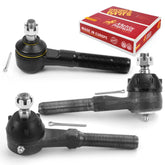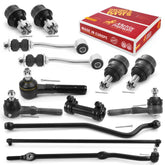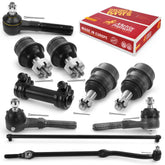Exploring the Differences Between Lower and Upper Ball Joints
Suspension systems in vehicles are complex and rely on various parts to function correctly. One crucial component is the ball joint, which connects the control arm and steering knuckle while allowing for flexibility and stability. It's worth noting that there are two types of ball joints- upper and lower- that work together to ensure smooth and safe driving. They serve distinct roles within a vehicle's suspension system. Here are the key differences between these two types of ball joints:
-
Location and Orientation:
- Upper Ball Joint: Positioned at the top of the front suspension, connecting the upper control arm to the steering knuckle or spindle. This arrangement allows the upper ball joint to control the alignment of the front wheels.
- Lower Ball Joint: Located at the bottom of the front suspension, connecting the lower control arm to the steering knuckle or spindle. The lower ball joint carries the weight of the vehicle and its occupants, providing stability and load-bearing capabilities.
-
Load-Bearing Function:
- Upper Ball Joint: Generally, the upper ball joint is not primarily designed to bear the weight of the vehicle. It allows the suspension to move and pivot without carrying the load, focusing more on alignment and suspension movement.
- Lower Ball Joint: The lower ball joint is a load-bearing component responsible for supporting the weight of the vehicle and transferring it from the suspension to the wheels. It also absorbs the impact of road irregularities.
-
Alignment and Handling:
- Upper Ball Joint: The upper ball joint's alignment control helps maintain proper steering geometry and alignment angles. It influences the camber and caster settings, which affect handling, stability, and tire wear.
- Lower Ball Joint: While the lower ball joint also contributes to alignment stability, its primary role is to support the vehicle's weight and provide controlled suspension movement.
-
Wear and Replacement:
- Upper Ball Joint: Upper ball joints generally experience less wear and stress compared to lower ball joints. However, they can still deteriorate over time due to usage, road conditions, and environmental factors.
- Lower Ball Joint: Lower ball joints undergo more stress and wear due to their load-bearing function. They are subject to more frequent replacement, and failure can result in safety hazards and handling issues.
-
Impact on Handling:
- Upper Ball Joint: Degraded upper ball joints can lead to alignment problems, affecting steering response and stability. However, their failure may not pose as immediate a safety concern as lower ball joint failure.
- Lower Ball Joint: Worn or failed lower ball joints can lead to serious safety risks. They can cause handling problems, vibrations, and uneven tire wear, and in extreme cases, complete ball joint failure can result in loss of control.
In summary, both upper and lower ball joints are crucial for a well-functioning suspension system. However, they play distinct roles. Upper ball joints focus on alignment and suspension movement, while lower ball joints bear the vehicle's weight and enable controlled suspension motion. Regular inspection, maintenance, and timely replacement of worn ball joints are crucial for maintaining safe and reliable vehicle performance. It is easy to find the best parts for one’s own vehicle on the web. All suspension parts including upper and lower ball joints can be easily purchased on Metrix Premium Chassis Parts online shop at www.metrixpremiumparts.com.









